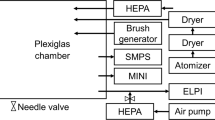Abstract
Individual particle analysis by scanning electron microscopy is a high resolution analytical technique which can provide the detail necessary to solve many particulate pollution problems. In an electron microscope a beam of electrons is focused on a specimen resulting in a number of signals which are used to collect chemical and morphological information from individual features either manually or automatically. Case studies are presented which illustrate the applications of the technique to three paniculate pollution problems of differing complexity.
Similar content being viewed by others
References
Del Monte M. and Sabbioni C. 1984. Gypsum crusts and fly ash particles on carbonate outcrops.Arch. Met. Geoph. Biocl., Series B.35, 105–111.
Del Monte M., Sabbioni C., Ventura A. and Zappia G. 1984. Crystal growth from carbonaceous particles.The Science of the Total Environment,36, 247–254.
Hanna R. B., Karcich K. J. and Johnson D. L. 1980. Determination of particle identities via a computer assisted SEM-EDXA system.Scanning Electron Microscopy, I, pp. 323–327. SEM Inc., AMF,O'Hare, Illinois.
Johnson D. L., Fortmann R. and Thomton I. 1982. Individual particle characterisation of heavy metal rich household dusts. In:Trace Substances In Environmental Health, XVI, pp. 116–123. University of Missouri, Columbia.
Johnson D. L., McIatyre B. L., Stevens R. K., Fortmann R. C. and Hanna R. B. 1981. A chemical element comparison of individual particle analysis and bulk chemical methods.Scanning Electron Microscopy. I, pp. 269–476. SEM Inc., AMF, O'Hare, Illinois.
Johnson D. L., Watt J. and Culbard E. B. 1985. Automated image analysis in scanning electron microscopy as an aid in tracing the source of lead in household and other dusts. In: T.D. Lekkas (ed.),Heavy Metals In The Environment, II, pp.404–406. Athens.
Lee R. J. and Kelly J. F. 1980. Overveiw of SEM based image analysis.Scanning Electron Microscopy, I, pp. 303–310. SEM Inc., AMF, O'Hare, Illinois.
McCrone. 1973.The Particle Atlas, Edn. II. Ann Arbour Science Publishers, Michigan, Ohio.
Mills C. F. 1969. Mineral nutrition and metabolism. In: D.P. Culhberson (ed),Nutrition of Animals of Agricultural Importance, Part 1, pp. 361–410. Pergamon Press, Oxford.
Read H. H. 1970.Rutley's Elements Of Mineralogy, 26th Edn. Allen and Unwin, London.
Suttle N. F. 1983. Effects of molybdenum concentration in fresh herbage, hay and semi-purified diets on the copper metabolism of sheep.J. Agric. Sci.,100, 651–656.
Author information
Authors and Affiliations
Rights and permissions
About this article
Cite this article
Heasman, I., Watt, J. Particulate pollution case studies which illustrate uses of individual particle analysis by scanning electron microscopy. Environ Geochem Health 11, 157–162 (1989). https://doi.org/10.1007/BF01758666
Received:
Accepted:
Issue Date:
DOI: https://doi.org/10.1007/BF01758666




